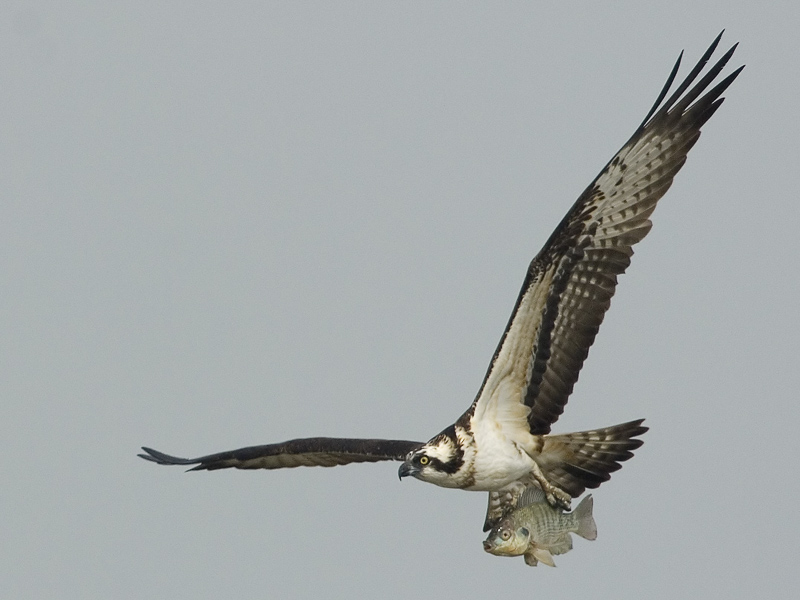Osprey Pandion haliaetus 鶚
Category I. Locally common passage migrant and winter visitor to Deep Bay and coastal areas mainly in the east of Hong Kong; scarce at other times.
IDENTIFICATION

Apr. 2007, Kinni Ho. Adult.
52-60 cm. Medium large raptor with relatively long outer wing, four primary fingers and relatively short tail. Adult is plain brown above and has a largely white body below apart from variable dark breast streaking, and a dark line through eye extending onto hindneck. Inner part of underwing has white lesser and median underwing coverts and dark primary coverts; underside of primaries pale with indistinct barring. Hovers over water before diving feet first for fish.

Oct. 2022, Paul Leader.
Juvenile has pale fringes to upperpart feathers, more extensive dark on throat and upper chest and obvious dark bars on underwing greater and median secondary coverts.
VOCALISATIONS
Has been heard giving short sharply downslurred ‘chewp’ calls and clear whistles that rise sharply in pitch before levelling off.
DISTRIBUTION & HABITAT PREFERENCE
Most records are from Inner Deep Bay, where it has been noted in all months, but it is also reported in coastal areas of the eastern New Territories each winter and in most summers and in Victoria Harbour, the coasts of Lantau and Castle Peak, and occasionally inland in the western and central New Territories in winter.
OCCURRENCE
Most reports occur from the last week of September to the third week of April (Figure 1). Peak numbers appear to occur from mid-October to the third week of February. In addition, there is a small passage in late March and April. On Po Toi single Ospreys have been recorded from 25 March to 27 April and on 17 May. In autumn there are fewer records from Po Toi from 5 October to 14 November. All double-figure totals have occurred in Deep Bay, the highest being 16 on 19 November 1994.
One or two birds occur each summer, with the highest count being five on 7 June 2013. It is presumed these summer records are non-breeding immatures and there is no suggestion breeding has occurred in HK. Cramp and Simmons (1980) state that many immatures stay in the wintering areas during their first and second summers. There are also isolated reports of single birds on passage, including one flying over Kowloon Peak (Fei Ngo Shan) on 9 April 1993.
No change in status is indicated by the historical records. It was recorded in HK mainly in winter by Swinhoe (1861), Vaughan and Jones (1913), Aylmer (1932), Herklots (1940) and Walker (1958).
BEHAVIOUR, FORAGING & DIET
Fish are the only food items noted. Birds are most frequently sighted perched on posts over water or hunting over bays and sheltered coastal areas, but are also regularly observed over gei wai, fish ponds and reservoirs.
RANGE & SYSTEMATICS
Breeds in northern North America and from northwest Europe and Scandinavia east through Russia, Kazakhstan, Mongolia and northeast China to Kamchatka; winters in northern South America and from sub-Saharan Africa east through the Indian subcontinent Indochina, south China and southeast Asia to the Greater Sundas (Bierregaard et al. 2020). In China a summer visitor to northwest and northeast, and a winter visitor to southern coastal provinces including Hainan and Taiwan (Liu and Chen 2020).
The nominate subspecies occurs in Europe and Asia, including HK, while two other subspecies occur in the Americas.
CONSERVATION STATUS
IUCN: Least Concern. Population trend increasing.
Figure 1.

Aylmer (1932). The birds of Hong Kong. Part IX. Order Accipitres (Falcons, Kites, Buzzards, Eagles, Hawks etc.). Hong Kong Naturalist 3: 3-5.
Bierregaard, R. O., A. F. Poole, M. S. Martell, P. Pyle, and M. A. Patten (2020). Osprey (Pandion haliaetus), version 1.0. In Birds of the World (P. G. Rodewald, Editor). Cornell Lab of Ornithology, Ithaca, NY, USA. https://doi.org/10.2173/bow.osprey.01
Herklots, G. A. C. (1940). Notes and Comments. Ornithology. Hong Kong Naturalist 10:63-70.
Liu, Y. and Y. H. Chen (eds) (2020). The CNG Field Guide to the Birds of China (in Chinese). Hunan Science and Technology Publication House, Changsha.
Swinhoe, R. (1861). Notes on the ornithology of Hong Kong, Macao and Canton, made during the latter end of February, March, April and the beginning of May 1860. Ibis 1861: 23-57.
Vaughan, R. E. and K. H. Jones (1913). The birds of Hong Kong, Macao and the West River or Si Kiang in South-East China, with special reference to their nidification and seasonal movements. Ibis 1913: 17-76, 163-201, 351-384.
Walker, F. J. (1958). Field observations on birds in the Colony of Hong Kong. Hong Kong Bird Watching Society, Hong Kong (duplicated).

